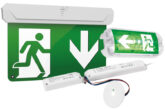
Advancements in smart lighting controls, such as self-testing emergency lighting, have improved reliability and efficiency.
These systems now handle routine flick tests and full discharge cycles automatically, while alerting any failures to maintenance teams. It’s a bit like cruise control for your lighting system—keeping things ticking without constant manual input.
And let’s be honest, manual testing is open to blunders. A common oversight? Engineers forgetting to reinstate mains power after a three- hour discharge. That’s not just a technical slip—it could leave residents without life-saving lighting until the next inspection rolls around. One small error, big consequences. So, is it time to fully trust self-test systems? Not quite.
While automation cuts out many of the usual slip-ups, it isn’t bulletproof. Software glitches, component failures, or good old-fashioned physical damage can still go unnoticed. Even Iron Man had the odd suit malfunction! Tech’s great, but it still needs someone to kick the tyres now and then. That’s why a hybrid approach makes sense.
Let self-testing handle the day-to-day jobs, but back it up with regular visual inspections. This ensures a robust safety system. Human inspection remains crucial for identifying issues that automation might overlook. Think of it like flying on autopilot—great for long stretches, but you still want a trained pilot in the cockpit.
In short, self-test technology is a powerful tool, and it’s getting better all the time. But for now, the smartest move isn’t to hand over the reins completely. Take the hybrid approach—let the tech do the heavy lifting, while keeping a sharp human eye on the details.
View our full emergency range here
Catch up on previous ‘Ask ROBUS’ articles here








